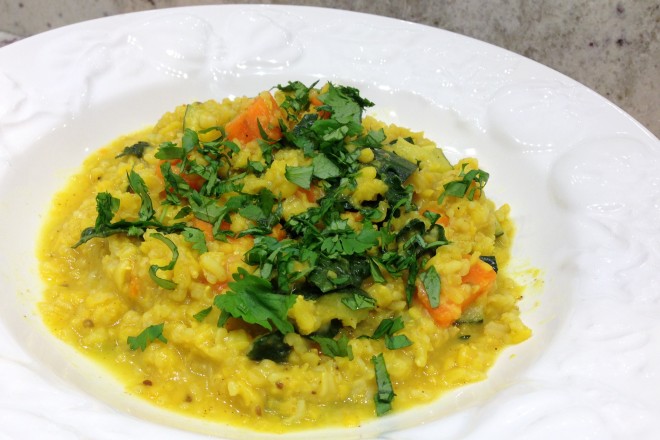
29 Dec Ayurvedic Healing with Kitchari

In Ayurvedic cooking, Kitchari is considered to be a cleansing and complete protein meal. This divine dish is not just tasty, but is very well known for its healing digestive power and how it balances one’s metabolism. Often times, Kitchari is given to a person looking to cleanse his or her body of accumulated ama (toxicity due to excess or improper foods that the body has not digested fully, leading to a variety of maladies from indigestion and gas to high cholesterol and more).
Health Benefits of Kitchari:
Known to be a strong blood and liver cleanser, it assists in healthy weight loss, helping the body’s tissues to detox what they don’t need and absorb the nutrients they do. The recipe below is especially ideal for people suffering with peptic ulcers, those with digestive issues, those doing spiritual practices who need to eat simple but nourishing foods, as well as those who need to avoid fried foods.
The best part, it’s really easy to make! There are lots of variations on Kitchari, but here’s one that I especially love making in the winter season. This recipe is healing for all doshas.
Kitchari Recipe:
Servers 2 to 3
- 1 cup basmati rice*
- 1 ½ cups split mung dahl with skins (skins should be used because of the increased vitamin content and roughage the skins provide).**
- 8 cups water, for cooking
- ¾ teaspoon salt
- 2 carrots, peeled and diced
- 1 beet, grated (optional)
- 2 tablespoons ghee
- ½ teaspoon black cumin seeds
Combine the rice and the dahl in a large bowl and add enough water to cover. Soak for 1 hour. Drain, wash, and rinse the mixture. Place it in a heavy pan and add the 8 cups of water and the salt. Cover tightly and bring to a boil over medium heat. Stir in diced carrots and grated beet, if desired. Reduce the heat and simmer for 30 minutes.
In an oven that’s been preheated to 450 degrees, Fahrenheit, place the tightly covered pan of cooked kitchari in the oven and turn off the heat. Allow to sit for 5 to 10 minutes to absorb excess moisture.
In a small frying pan, warm the ghee over medium heat. Add the cumin seeds and sauté until brown and fragrant. Serve the kitchari hot, topped with this great sauce.
Notes:
* If you can, use white basmati rice as it is the lightest and easiest to digest.
** Use mung dahl (yellow, split mung beans). Don’t use whole, green mung beans—they are not as digestive friendly and can cause extra gas or bloating. In the preparation of kitchari, the dal is soaked for no more than an hour. Though the dal takes a little longer to cook, it retains a firmer texture, which is something you want in a good kitchari.
Enjoy!
----
Support the Monkey
Every product in our articles and interviews is independently selected by (obsessive) editors. Products you buy on Amazon through our links feed the Monkey. Commissions from your Amazon purchases are crucial for us to continue to provide you with the content you love.
Supporting the Monkey costs you nothing – but it is dependent on using our Amazon links.
Click here to go directly to the AMAZON.COM Homepage

